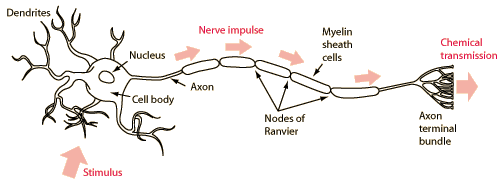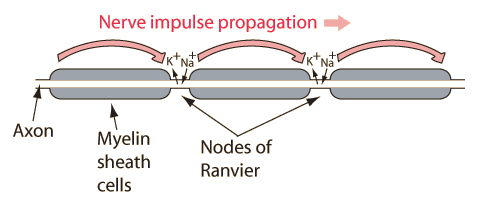Nerve Cell

Many nerve cells are of the basic type illustrated above. Some kind of stimulus triggers an electric discharge of the cell which is analogous to the discharge of a capacitor. This produces an electrical pulse on the order of 50-70 millivolts called an action potential. The electrical impulse propagates down the fiber-like extension of the nerve cell (the axon). The speed of transmission depends upon the size of the fiber, but is on the order of tens of meters per second - not the speed of light transmission that occurs with electrical signals on wires. Once the signal reaches the axon terminal bundle, it may be transmitted to a neighboring nerve cell with the action of a chemical neurotransmitter.
The dendrites serve as the stimulus receptors for the neuron, but they respond to a number of different types of stimuli. The neurons in the optic nerve respond to electrical stimuli sent by the cells of the retina. Other types of receptors respond to chemical neurotransmitters.
The cell body contains the necessary structures for keeping the neuron functional. That includes the nucleus, mitochondria, and other organelles. Extending from the opposite side of the cell body is the long tubular extension called the axon. Surrounding the axon is the myelin sheath, which plays an important role in the rate of electrical transmission. At the terminal end of the axon is a branched structure with ends called synaptic knobs. From this structure chemical signals can be sent to neighboring neurons.
| Transmission of nerve impulse along the axon |
Contributing author: Ka Xiong Charand
Bioelectricty
| HyperPhysics***** Biology | R Nave |
